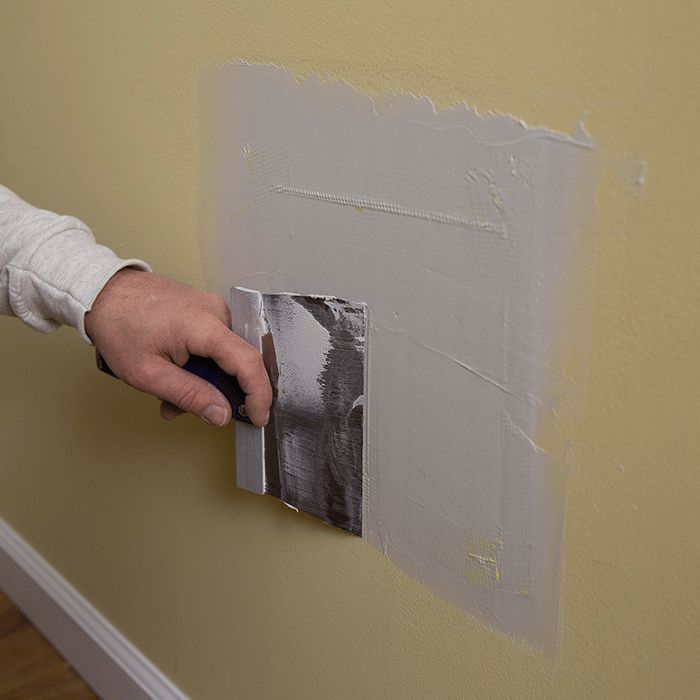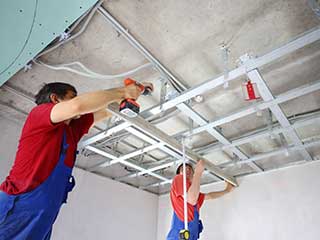Discover the Finest Practices for Effective Drywall Repair and Installation
The art of drywall repair work and installation calls for a mix of ability and precision. Understanding the necessary tools is vital for accomplishing a smooth finish. Comprehending the step-by-step process can make a significant difference in the outcome. Proper techniques for taping and mudding are additionally critical. What stays is the knowledge of upkeep that guarantees durability. These aspects with each other produce a refined outcome worth discovering additionally.

Crucial Devices for Drywall Repair Work and Installment
When taking on drywall repair work and setup, having the right tools can significantly boost the performance and quality of the job. An utility blade is important for cutting drywall sheets specifically, while a drywall saw can aid in making a lot more detailed cuts. Taping blades, offered in numerous dimensions, are important for using joint compound efficiently and uniformly. A drywall sander, preferably with a dirt collection attribute, aids attain a polished finish, minimizing the need for substantial cleanup.
Furthermore, a gauging tape assurances precise measurements, and a degree makes sure that installments are straight and plumb. Security gear, consisting of dust masks and safety glasses, must not be ignored to secure against particles and dust. Ultimately, a stud finder aids in situating framing members, ensuring safe installment. By equipping oneself with these necessary tools, the repair and setup procedure becomes much more manageable and causes a professional-quality result.
:max_bytes(150000):strip_icc()/SPR-solutions-to-common-drywall-problems-p2-4120949-not-on-stud_53719-051c5226ba8f478086c3994975acf8c9.jpg)
Step-by-Step Guide to Patching Holes
Patching openings in drywall needs an organized strategy to assure a smooth fixing. The location around the hole must be cleaned and any loosened particles eliminated. For little holes, a putty knife can be made use of to apply a lightweight spackle, pressing it right into the hole and smoothing the surface. After it dries out, fining sand is important to develop a flat coating. For larger openings, a patch of drywall might be needed. This involves cutting an item of drywall somewhat bigger than the hole, securing it to the wall surface with screws, and using joint substance to cover the joints. When the substance dries, it needs to be sanded smooth. Keying the patched location before paint will guarantee an also finish. Following these actions will lead to a professional-looking repair that blends perfectly with the bordering wall surface.
Methods for Smooth Drywall Setup
Achieving seamless drywall installment needs cautious planning and implementation. First, it is vital to reduce and determine drywall sheets properly to minimize spaces. Utilizing an energy knife, installers must rack up the board prior to breaking it along the cut line, guaranteeing tidy edges. Appropriately straightening the sheets is essential; starting from the leading and functioning down assists maintain uniformity.
Securing drywall to the studs needs consistent spacing, typically every 16 inches, utilizing screws instead than nails for better hold. This technique minimizes the threat of pops gradually. In addition, staggering the seams between sheets enhances structural honesty and minimizes the presence of joints.
Utilizing the appropriate thickness of drywall for particular areas-- such as moisture-resistant kinds in bathrooms-- more contributes to a perfect surface. Adhering to these methods will lead to a smooth and professional-looking installment, setting the stage for the succeeding ending up procedures.
Finishing Touches: Taping and Mudding
Completing touches, such as taping and mudding, play a vital function in achieving a polished drywall surface. Insulation entails using a slim strip of drywall tape over the joints and joints, guaranteeing a smooth look. This process aids protect against splits and produces a strong bond in between drywall sheets. It is important to pick the best kind of tape, with paper and fiberglass harmonize being the most common choices.
Mudding, or applying joint substance, adheres to taping. This compound loads in spaces and smooths out the surface area for a consistent finish. It is typically used in multiple layers, with each coat requiring to dry prior to fining sand. Appropriate technique entails feathering the sides to blend the substance into the bordering drywall, minimizing presence.
When completed correctly, taping and mudding improve both the architectural and aesthetic stability of the drywall installment, leading to a professional-quality coating.
Tips for Maintaining Your Drywall After Installation

Furthermore, preserving a constant interior moisture degree can avoid bending or mold and mildew growth. Making use of a dehumidifier in moist areas, like basements, is advisable. It's additionally valuable to regularly repaint locations that reveal wear, as this shields the underlying product. Lastly, when relocating furniture or installing components, caution must be exercised to stay clear of damaging the drywall. By adhering to these upkeep suggestions, house owners can prolong the life of their drywall, guarding it continues to be an attractive function of their interiors.
Often Asked Questions
What Security Equipment Is Required for Drywall Fixing and Installation?
For drywall repair service and installation, necessary safety gear consists of safety and security goggles to safeguard eyes, Look At This dirt masks to stop breathing of fragments, gloves for hand security, and knee pads for convenience throughout extended kneeling. drywall contractor.
Exactly how Do I Establish the Drywall Thickness Needed for My Job?
To figure out the drywall density needed for a job, one must consider the wall surface's architectural requirements, local building regulations, and the meant use the room, commonly selecting 1/2-inch or 5/8-inch drywall.
Can I Repair Drywall Without Removing Furnishings From the Area?
Yes, drywall can be fixed without eliminating furnishings from the space. Cautious planning and protective measures can decrease mess, permitting reliable fixings while keeping surrounding things safe from dust and damages during the procedure.
What Kinds of Drywall Are Ideal for Different Settings?
Moisture-resistant drywall is suitable for kitchens and shower rooms, while soundproof drywall fits shared wall surfaces in apartment or condos. Fire-rated drywall is best for garages, and common drywall functions well in basic living locations, making sure longevity and suitability for numerous atmospheres.
The length of time Does It Take for Drywall Mud to Dry Totally?
Drywall mud normally takes 24 to two days to completely dry completely, depending on elements like humidity and temperature level (Drywall Repair Ogden UT). Thicker applications might call for longer drying out times, while thinner layers can dry out extra promptly. Proper ventilation aids drying out
The art of drywall repair and installation requires a blend of skill and accuracy. When carrying my sources out drywall repair work and setup, having the right tools can considerably improve the effectiveness and high quality of the job. An utility blade is vital for cutting drywall sheets precisely, while a drywall saw can aid in making much more elaborate cuts. Attaining seamless drywall setup demands cautious planning and implementation. Moisture-resistant drywall is suitable for restrooms and navigate here kitchen areas, while soundproof drywall matches shared walls in houses.